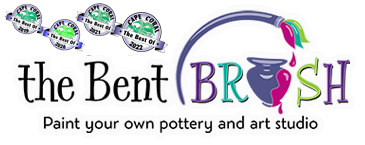 It’s a lovely thing to have handmade items around your house. To hand a friend a mug of coffee in a mug you painted yourself is so much fun, but it definitely feels better if your friend is exclaiming over how beautiful that mug is. Because let’s face it, when you are spending time and money doing something creative, you want to be proud of the way it looks when it’s done.
It’s a lovely thing to have handmade items around your house. To hand a friend a mug of coffee in a mug you painted yourself is so much fun, but it definitely feels better if your friend is exclaiming over how beautiful that mug is. Because let’s face it, when you are spending time and money doing something creative, you want to be proud of the way it looks when it’s done. That’s why we provide classes at our studio, and it’s also why we started this blog. We wanted to be able to give you creative ideas to make beautiful things for your own home and to give away as gifts, and we want you to be proud of your work. These techniques are the same techniques the professionals use, but they are easy enough for the novice to use creatively too.
This week we are talking about masking techniques. Masking allows you to create intricate designs on your pottery piece while leaving some nice crisp edges between either the glaze and the underlying bisque wear or between different layers of glaze. Masking is kind of the opposite of using stamps, stencils or silkscreens. Stamps, stencils and silkscreens are used to apply glaze in a pattern. With masking you are using the mask material to create the pattern, but it is used to resist the glaze. So while the glaze will follow the lines of a stamp, the opposite will happen with a mask. If you apply a mask to a piece of bisque that has no glaze at all on it and then apply a glaze, the part of the pottery that has was masked will stay the color of the fired bisque while the rest of the pot will be glazed when the pot is fired.
There are a number of different materials that can be used for masking, and we’ll cover a few of them here.
Paper Masking —With this technique, you will simply cut your design out of plain copy paper and place the design where you want it on your pottery. To keep your paper in one place you need to apply it to painted bisque because the paint is what the paper adheres to, and also that means you won’t be leaving a section of your pottery where the bisque is still raw looking since it won’t have any glaze on it. Then simply paint your pottery with another color glaze and remove the paper once the glaze has lost its sheen.
Contact Paper—Because contact paper has a sticky side, it can be more precise than plain paper. Again you simply cut your design out of the contact or shelf paper with scissors or an exacto-knife. Then figure out where you want to place it on your piece of dry pottery. Carefully remove the backing to adhere the contact paper to the pottery and to make sure it has a nice sealed edge take your fingers and moving from the middle of the paper to the edges to remove any air bubbles. Now simply paint your glaze over piece of pottery and on top of the sticker. Wait for the glaze to lose it’s sheen and then remove the contact paper from the pottery before firing the piece.
Pre-made stickers—Nowadays there are stickers in all sorts of wonderful shapes and sizes, and using pre-made stickers can be a very easy way to get a beautiful professional looking design. Whether it’s simple stars or dots, or a more intricate snowflake or even the shape of a Disney Character, it’s lovely to get the kind of precision you can with these types of stickers. Again the technique is to apply the sticker to your dry pottery in whatever pattern you want, then glaze it and remove the stickers before firing.
Tape Resist—For crisp, fine lines with sharp edges and angles, use thin masking tape or painters tape to mask the pottery. You can do stripes, or checkered, or even plaid patterns using this technique. It’s also a great tool to use when you want to use two or more glazes on your pots without the worry of them overlapping in unwanted areas. Using tape as a resist in ceramics is similar to using painter’s tape when masking off edges on a wall when painting your home. Use it to block out areas of decoration or to designate a clear edge when decorating work.
Objects in Nature—Believe it or not, you can even use such objects as shells or leaves as a mask. Leaves in particular do really well as both a stencil and a mask. You simply place the item on your piece and paint the glaze over it and then remove the object before firing it.
We do Classes at the Bent Brush every week and also throw special Events because we love teaching new techniques. Check out those pages on our website and sign up! Or please feel free to just walk in any time you’d like to do some painting!
